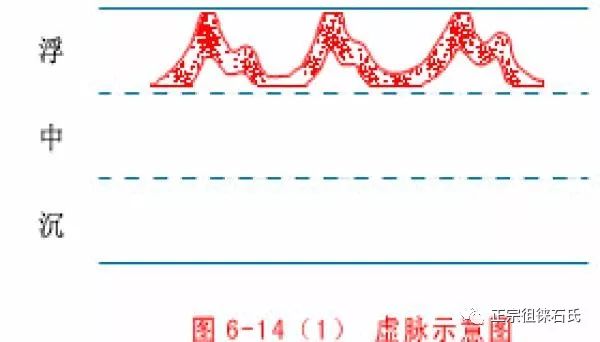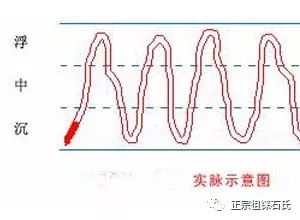9.Xu Mai (Deficient Pulse)

Diagram of Xu Mai
According to the “Pulse Classic, Volume One”: “Xu Mai is slow, large, and soft; when pressed, it feels insufficient, and the fingers feel empty.” The “Essentials of Surgery” states that the diagnosis of Xu Mai is: “When pressed, it feels insufficient, slow, large, and soft, with a light touch feeling empty beneath the fingers.” The “Three Finger Zen” summarizes its characteristics as: “Xu Mai is large and loose, slow with little strength.”
【Pulse Characteristics】 The three positions of the pulse are weak and feel empty when pressed.
Xu Mai is characterized by a soft and weak pulse that is large in shape. In all three positions (cun, guan, chi), whether superficial or deep, it lacks strength. Due to its large shape, it feels weak when pressed, hence the sensation of emptiness. Therefore, the characteristics of Xu Mai should be diagnosed based on its strength and shape. The “Four Word Essentials” states: “Large shape and thin strength indicate its deficiency.” The “Pulse Diagnosis Compendium, Volume Three” states: “Xu means the symbol of emptiness and insufficiency, soft and weak is its name.”
Since the “Pulse Classic” mentions that Xu Mai has a slow quality, later physicians have often followed this interpretation, as seen in the “Essentials of Surgery”, “Binhai Pulse Studies”, “Correct Eye of Diagnosis”, and “Four Diagnostic Methods”. As for whether slowness is a factor in constituting Xu Mai, it seems unnecessary to emphasize, as Xu conditions can differ in yin, yang, qi, and blood. Although Xu Mai is observed, the accompanying pulse can also differ. For example, the “Complete Book of Jingyue, Chapter on Pulse Spirit” states: “Xu Mai indicates deficiency of righteous qi, lack of strength… Floating and weak indicates blood deficiency, sinking and weak indicates qi deficiency, rapid and weak indicates yin deficiency, slow and weak indicates yang deficiency.” From this, it can be seen that the number and position of the pulse are not specific factors constituting Xu Mai; it can be both slow and rapid, and both floating and sinking. To distinguish Xu Mai, the key point is its large and soft quality.
【Differentiation】 See floating pulse.
【Main Conditions】 Xu Mai indicates deficiency conditions. Whenever there is insufficient qi and blood, loss of blood leading to counterflow, prolonged illness leading to deficiency, yang deficiency causing cold, yin deficiency causing heat, or heat injury, Xu Mai can be observed. As stated in the “Twenty-Four Pulses and Their Main Conditions” in the “Three Causes Formula”: “Xu indicates cold, weak feet, deficiency, indigestion, and heat injury.” The “Key Points of Diagnosis” states: “Xu… indicates deficiency of both qi and blood, heat injury, excessive sweating, confusion, and fright in children.”
【Accompanying Pulse Conditions】 Commonly seen are: floating xu indicating qi deficiency, or exterior deficiency with sweating; sinking xu indicating interior deficiency, xu and rough indicating blood deficiency, xu and rapid indicating yin deficiency, xu and slow indicating cold deficiency. The “Pulse Theory Seeking Truth” states: “Therefore, floating and xu indicates qi decline, sinking and xu indicates weak fire, xu and slow indicates cold deficiency, xu and rapid indicates water depletion, xu and rough indicates blood deficiency, xu and string-like indicates earth decline and wood flourishing…”
【Pulse Theory】 Qi deficiency is insufficient to move the blood, hence the pulse feels weak; blood deficiency is insufficient to fill the pulse pathway, hence it feels empty when pressed. Due to qi deficiency not being contained and expanding outward, blood deficiency leads to qi having nowhere to go.
【References】
(1)“Introduction to Medicine: Pulse Diagnosis” states: “Xu indicates both qi and blood deficiency, hence often leads to confusion and fright.”
(2)“Correct Eye of Diagnosis, Volume Two” states: “Xu indicates blood deficiency and also indicates heat injury. Left cun indicates heart deficiency, leading to confusion and fright; right cun indicates lung deficiency, leading to sweating and qi deficiency. Left guan indicates liver injury, leading to blood not nourishing the tendons; right guan indicates spleen cold, leading to indigestion. Left chi indicates water decline, leading to weakness in the waist and knees; right chi indicates fire decline, leading to cold symptoms.”
10.Shi Mai (Excess Pulse)

Diagram of Shi Mai
According to the “Pulse Classic, Volume One”: “Shi Mai is large and long, slightly string-like, and when pressed, it feels solid beneath the fingers.” The “Book of Living People, Volume Two” states: “Shi Mai is large and long, and when pressed, it feels solid beneath the fingers, whether floating or sinking.” The “Correct Eye of Diagnosis, Volume Two” summarizes its characteristics as: “Shi Mai is strong, long, and firm, responding solidly beneath the fingers in all three positions.”
【Pulse Characteristics】All three positions of the pulse are strong when pressed.
Shi Mai is characterized by a strong pulse in all three positions (cun, guan, chi), whether floating, middle, or sinking, with a feeling of fullness beneath the fingers, exhibiting a long, large, and powerful quality. The “Binhai Pulse Studies” states: “Both floating and sinking are large and long, responding solidly beneath the fingers without feeling empty.”
【Differentiation】Shi Mai is similar to tight, firm, and surging pulses, all of which are strong pulse types, but Shi Mai should feel solid and strong beneath the fingers, whether floating or sinking; tight pulses feel tense and strong, like a taut rope. The “Binhai Pulse Studies” states: “Shi Mai is strong whether floating or sinking; tight pulses feel like a taut string and are not constant.” The differentiation between Shi Mai and surging pulse has been discussed previously.
【Main Conditions】Shi Mai indicates excess conditions, whenever there is excessive heat or excess pathogenic factors, leading to mania, delirium, or yang toxicity causing constipation, or excessive fire in the three burners. As stated in the “Essentials of Surgery”: “The diagnosis of Shi Mai is… due to the excess of pathogenic factors and the organs being solid.” The “Pulse Study Justice” states: “Shi indicates symptoms of excess heat, or mania and delirium, or yang toxicity causing constipation, or heat in the spleen leading to fullness…” The “Treatise on Febrile Diseases: Differentiating Yangming Disease Pulse and Symptoms” states: “If the patient is feverish and sweating, it indicates a resolution; if the pulse is Shi, it indicates that it should be purged.” This is an example of heat accumulation in Yangming, where the pulse is Shi and can be purged.
Shi Mai indicates excess conditions, and this has been consistent among physicians throughout history. However, Shi Mai can also be seen in conditions of cold and stagnation, and in prolonged deficiency conditions, Shi Mai can appear as a paradoxical pulse. The “Pulse Meaning Simplified” states: “In prolonged illness, a solid pulse is ominous; can it be treated with dispersing agents? There are also cases of internal cold stagnation, where the pulse feels solid and strong, and cannot be treated with cooling agents, but should be warmed with ginger and cinnamon. The “Four Diagnostic Methods” states: “If there is diarrhea and blood loss, or sudden deficiency after childbirth, and a solid pulse is found, it is difficult to treat.” When the righteous qi is weak, the pulse should be weak; if the pulse is solid, it indicates excess pathogenic factors, and the righteous qi is weak, which is a poor prognosis, hence it is said to be difficult to treat.
Even healthy individuals can exhibit Shi Mai, which indicates sufficient righteous qi and good organ function. In healthy individuals, Shi Mai should be calm and gentle, unlike the Shi Mai associated with disease, which is often agitated and hard. The “Inner Canon” states: “Blood is solid, and the pulse is solid.” The “Pulse Language” states: “Solid and calm, all three positions are strong, indicating excess qi and blood.” This refers to the Shi Mai of healthy individuals.
【Accompanying Pulse Conditions】Floating Shi indicates exterior excess; sinking Shi indicates interior excess, leading to fullness, obstruction, pain, and accumulation; surging Shi indicates excess heat; slippery Shi indicates phlegm accumulation. The “Pulse Diagram Explanation” states: “Solid and tight indicates cold accumulation; solid and slippery indicates phlegm accumulation; solid and long indicates sufficient organ qi, solid and rapid indicates heat accumulation in the organs.”
【Pulse Theory】Excess pathogenic factors are strong while righteous qi is not deficient, leading to a clash between excess and righteous, causing qi and blood to be abundant, hence the pulse feels solid and strong beneath the fingers.
【References】
(1)“Complete Book of Jingyue, Chapter on Pulse Spirit” states: “Shi Mai indicates excess pathogenic factors… indicating stagnation in the three burners. Exterior excess is indicated by a floating, large, and strong pulse, caused by external wind, cold, heat, or dampness, leading to febrile diseases, headaches, nasal congestion, and swelling; for muscle and joint pain, carbuncles, and toxins. Interior excess is indicated by a sinking, solid pulse, caused by internal injury from food and emotions, leading to fullness, obstruction, masses, blood stasis, phlegm, abdominal pain, and cough.”
(2)“Correct Eye of Diagnosis, Volume Two” states: “Zhang Jiegu’s erroneous view that Shi indicates cold deficiency, and thus ginger and other warming treatments should be applied, is not to be followed. If the pulse is solid and also tight, it may be appropriate; however, if it is not a tight pulse, applying warming agents to a person with great heat is likely to be fatal! Zhang Jiegu’s wisdom must surely indicate that the treatment method for a tight pulse is correct.”

